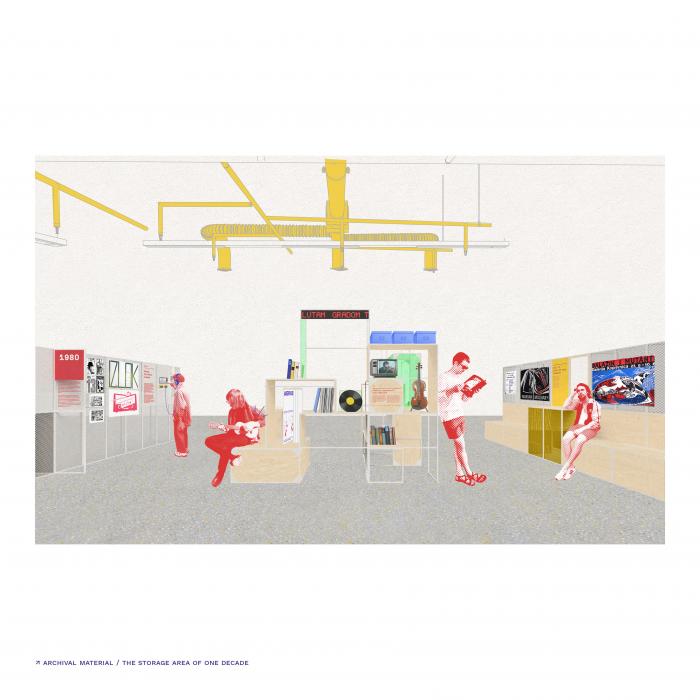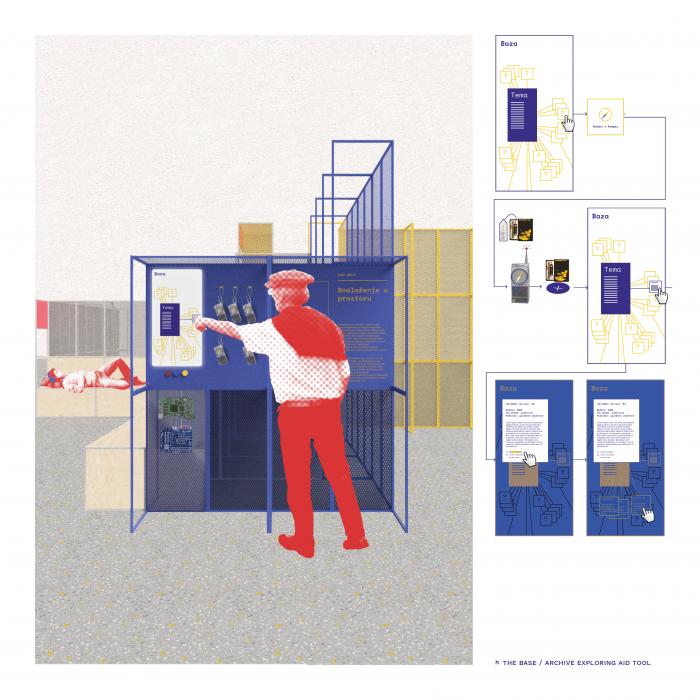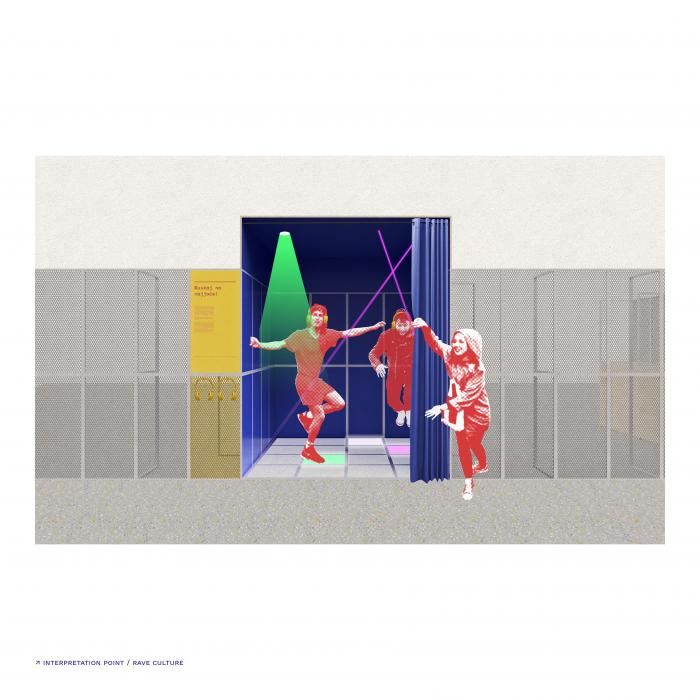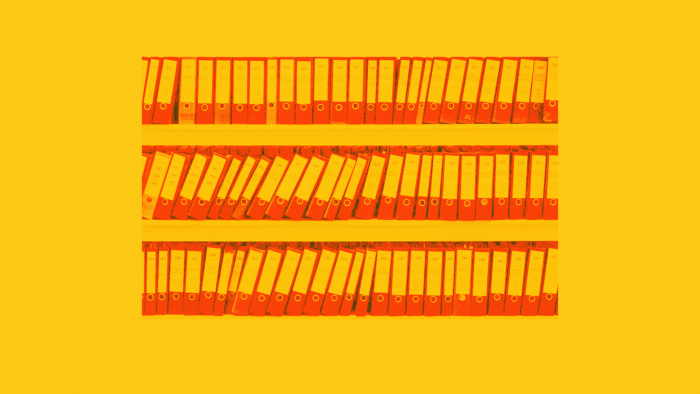How can one maintain the life of an archive? Where does the role of a community come into place? How can a community breathe life into its culture and create something living? The Living Archive represents a place of community and the new model of an archive — a platform for the affirmation and preservation of alternative and innovative, mostly independent, cultural and artistic practices as cultural heritage. The project is based on public and private archives of Koprivnica’s local community.
The Living Archive is a master’s thesis project which represents a place of community and the new model of archive — a platform for the affirmation and preservation of alternative and innovative, mostly independent, cultural and artistic practices as cultural heritage. The project is based on the research of cultural, alternative and music scene of the city of Koprivnica (Croatia), from 1970’s onwards. The research arose from the need for affirmation of the local scene in order to be a part of local recollection and history— in the future. With the desire that citizens' action and creation would become part of city's everyday life and identity, a new meaning of a place, a new model of archive which could make this possible has been developed.
A new model derives from redefining traditional understanding of archive’s meaning, space and way of use. The project’s goal is to strengthen local community, intergenerational relationships and preserve community’s recollection. A redefined meaning of archive signifies it’s no longer a place of storing official documents, but a place of preserving certain ways of living and creation from oblivion. A redefined way of use means open access to archive records and cultural production to all people. A boundary between an archivist and a visitor becomes blurred. Archivist’s knowledge helps with the logic of sorting and preserving records. A party becomes the participant, the visitor, the one who creates, records and stores. The archetype of archive’s space is changed. Storage becomes visible and available to explore. The Archive’s space consists of storage zones, research/production workstations, interpretation points and community gathering zones.
The arrival of visitors in The Living Archive, the mutual interaction and exchange of knowledge signifies the revival of Archive — a space that is alive and lives on.
Mentor: Ivana Fabrio
Associate: Nina Bačun
Master’s thesis project at School of Design, University of Zagreb
Please highlight how the concept/idea can be exemplary in this context
The active use of Archive implies studying the archive records and scrutinising the ways of cultural production related to the past. This can be achieved through research/production workstations: visual, auditory, textual and the object one. All of them are used for research and manipulation of old records, production of new cultural shapes using archive records as an inspiration.
These workstations consist of interactive artefacts and touch screen interfaces. The artefacts are made of old device cases and parts in combination with new technologies. They represent research aid tools with an educational dimension. E.g.: Auditory workstation supports both research of audio records (listening, searching through filters) and production (sound modification, recording, adding effects, playlist materialisation etc.). The artefact — an old magnetic tape-recorder — becomes a physical interaction interface for sound rewinding, thus keeping part of its original shape in addition to its new function.The object workstation gathers knowledge, skills and experience from The Archive and transfers it all into physical matter. The workstation supports DIY, DIWO and open-source principles. It represents cultural production and reparation. Through it, Artefacts can be made. People learn about the means of cultural production and then make their own, e.g. audio-visual experiments, through matter and objects.
Meaning that abandoned objects would be saved from end of their use cycle and their lifetime would be prolonged. Through the principles of reusing, repairing or refurbishing the objects would be put back to use and given their old or new functions. in service of The Living Archive. Therefore, environmental and ecological awareness are implemented into the project by creating a circularity lifecycle of forgotten objects. There is also an indication of non-material circularity — where knowledge and skills are being transferred from older generations to new ones and other way around.
Please highlight how the concept/idea can be exemplary in this context
The aesthetics of this project comes from one of the main characteristics that the project reflects — connectedness. The Archive is a set of connections which link records — artefacts scattered among institutions and people — and finally brings them together, to a place. Records are connected by type, period or author. The archival material united in one place brings together people of different interests, who can now find a common language. The Archive could become a network of the local community, connecting past and future.
Connectedness, openness, production and accessibility are all visible in the spatial design of The Archive. The space is built from simple modular elements which can be rearranged easily by The Archive’s community. Furthermore, modularity of spatial elements allows The Archive to be spatially changeable, like a living organism. Joined together, the elements can take different formations and seem like spatial mesh, interlinking different kinds of archive material, periods of time and people. Elements are designed as a display system — displaying archival material, information and interactions — through different characteristics: open, closed, working, hidden, changing, partitioning and communicative. Elements are made from metal square tubes in order to be durable and serve many purposes. The joints are visible, as The Archive’s characteristics are openness and visibility.
The quality of one’s experience in The Living Archive should not be connected with its beauty, but it should derive from quality and quantity of interaction possibilities. Moreover, it should derive from one's involvement. The visitors can experience more through interpretation points and The Base. Interpretation points explain the context of time to visitors and The Base is a tool which provides a combination of digital and physical exploration and finding of the archive records. Exploring through The Base is enabled by The Archive’s artefact, The Cultural Compass.
Please highlight how the concept/idea can be exemplary in this context
Parts of the local history are scattered through unsystematic archives of local institutions, private collections and people's memory. A new archival/community platform would be established through a combination of bottom-up and top-down approaches where institutions, local community and designers would collaborate. In this project bottom-up signifies a direct impact on the archive platform with the creation of archival content by community (in the past and the future) and brings the community closer. Top-down approach brings institutions (eg. museum, library, city archive, etc.) and their mutually scattered archives closer to the community and it makes institutional collections finally open and accessible to all. A collaboration with institutions does not imply taking over their patterns and model of work. The collaboration signifies a combination of institutional systematics and organisation with openness of initiatives created bottom-up.
Thanks to the redefinition of meaning and use of archive, in The Living Archive project the local community becomes the decision maker about which parts of archival collections should be preserved. The archival records were (are, and will be) created by the community. Research/production workstations are also an inclusive segment of The Archive. With the ease of workstations’ use, creation and cultural production are becoming accessible to all.
The Archive becomes a place which preserves for the future, a place which is dynamic, changing, communicative, a place that invites and brings inclusion in the community with its (new) programmes. The Archive becomes the place that activates the community, and the community, in return, simultaneously activates the Archive. Therefore, the community writes its own history, builds new relationships and meanings and rebuilds forgotten ones.
Please highlight how this approach can be exemplary
All of the three mentioned dimensions are intertwined through the space and the experience of The Archive. Intertwining and connectedness, for example, can be explained through already mentioned object workstation.
At the object workstation, visitors can learn about the ways and tools of cultural and artistic production in the past, but they can also create artefacts. Artefacts represent interactive objects made from old device cases and parts in combination with new technologies of the present. Creating artefacts by reuse, refurbishment and repair brings old forgotten things to life and lowers the number of newly produced ones. Therefore, the project reflects an environmentally sustainable dimension where the life cycle of dead objects restarts. Throughout the process of creating artefacts, people learn about their new and old functions. Older generations teach the younger ones about the past, and the younger teach the older about the present. Older people now have a chance to get new roles and to be actively included in the community. Hence, intergenerational connectedness and inclusion occurs. With created artefacts, the space of The Living Archive has gained a unique and impressionable aesthetics. Artefacts also boost up the experience of The Archive’s visitors by its interactive features.
A new model of archive brings innovative character to the understanding of “archive” compared to its traditional meaning. The approach to the traditional archive is completely turned around, from closed to open, from institutional or community one to the combination of both. From archiving mainstream official records to archiving something unique and meaningful to the community — archiving the community's creativity, its collective recollection.
The new model of archive is applied to the case of a small city of Koprivnica. A phenomenon of quantitatively and qualitatively rich, (mostly) independent, alternative cultural production and action has been noticed during the last 50 years. It is not recognized by the local authorities as something of high value, as heritage, as something needed to be preserved for the future generations, but with the concept of The Living Archive, this smaller-scale, local phenomena could be preserved. Not only in Koprivnica, but also in other places and communities. For the city, an establishment of this kind of a place would add an innovative dimension to the city itself and bring something completely new, and at the same time old and forgotten, to the local area and community.
Visitors of The Archive do not only watch, read or listen to archival material. At The Living Archive, the material can be interpreted and actively used. With this concept, The Living Archive becomes a combination of an actual place of archive, museum, library, lecture room, workshop and community space. It connects individuals of different backgrounds, interests and knowledge leading to hybridity of creation, content and action — hybridity of culture.
The general plan of the further development is firstly, gathering a team of people of interest in the project idea and in the cultural area, particularly related to the local scene. Despite the fact that the local history has been researched and explored through a master’s thesis project,, there should be conducted a more professional and thorough research, with a team specialised in certain areas useful for the project. Local people should be directly involved in the project, with their knowledge about local history and with certain decision making. The institutions would have to make a compromise and cooperate in order for The Living Archive platform to succeed. If physical archive materials would be shared to the platform by institutions and citizens, and the community would have positive reactions towards it, The Living Archive should get its material, spatial form, in the future in existing or newly designed building structure.
If The Living Archive would be awarded in the New European Bauhaus Prizes 2022, throughout the following year the plan of my actions would be:
- A brief and simple introduction about the concept would be presented to the community.
- Finding interested participants inside community and local culture related NGOs.
- Meeting with local NGOs and trying to connect the platform to their initiatives. The support of NGOs would mean better visibility and greater chance of initiating the idea of The Archive.
- With NGOs support, the idea of the project would be presented to local institutions. Institutions’ and city’s support would be sought in terms of giving access and being open to share their specific archive collections needed for the project’s realisation.
- Establishing The Living Archive Platform, a civic-institutional initiative that would continue to operate.
- Gathering a working team of experts in various fields, that have interest in the project (designer, architect, art historian, archivist, librarian, museologist, etc.).
- Seeking financial support for the working team.
- Seeking adequate space for the platform in the initial phase.
- Creating a campaign to bring the project and its idea closer to the community.
- Gaining trust of the community in order to make a quality collaboration with them.
- Conducting workshops to connect (with) the community and involving them in the project in order to gain a sense of belonging.
- Although research has been made through the master’s thesis project, if The Living Archive is to realise in the future, a more thorough and professional research should be conducted and more culture actors should be interviewed and included. This would signify a beginning of a longer process of research which would continue after June 2023. Next research steps are:
a. Building a systematic network of cultural actors and conducting interviews.
b. Voluntarily gathering and sorting of physical materials that would become a part of The Archive.
@Virag, 2022
Content licensed to the European Union.





